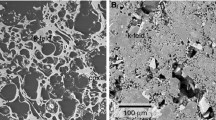Abstract
Two steady-state models of magma flow in a conduit are considered, with and without allowance for magma compressibility. As distinct from studies [{xc1}–{xc6}], in which either simplified equations were solved or unrealistic values of the parameters were used, in the present study the complete systems of equations are solved and the values of the parameters correspond to magma flow in a volcanic conduit. The secondary flows obtained in [{xc5}] for model conditions are not formed when the magma is simulated by an incompressible fluid and all the terms of the equations are taken into account. When the magma compressibility is taken into account, in the isothermal case and for constant magma viscosity the entire flow is adequately described by the one-dimensional isothermalmodel, although this approach is not formally applicable.
Similar content being viewed by others
References
A.A. Barmin, E.A. Vedeneeva, and O.E. Mel'nik, “Effect of ViscousDissipation on Nonisothermal High-Viscosity Magma Flow in a Volcanic Conduit,” Fluid Dynamics 39(6), 863–873 (2004).
E.A. Vedeneeva, O.E. Mel'nik, A.A. Barmin, and R.S.J. Sparks, “Viscous Dissipation in Explosive Volcanic Eruptions,” Geophys. Research Letters 32, No. 5, L05303.101029/2004GL020954 (2005).
A. Costa and G. Macedonio, “Viscous Heating in Fluids with Temperature-DependentViscosity: Implications for Magma Flows,” Nonlinear Processes in Geophysics 10, No. 6, 545–555 (2003).
H. Massol and C. Jaupart, “The Generation of Gas Overpressure in Volcanic Eruptions,” Earth and Planetary Science Letters 166, No. 1–2, 57–70 (1999).
A. Costa and G. Macedonio, “Viscous Heating Effects in Fluids with Temperature-Dependent Viscosity: Triggering of Secondary Flows,” J. Fluid Mech. 540, 21–38 (2005).
H. Massol, C. Jaupart, and D.W. Pepper, “Ascent and Decompressions of Viscous Vesicular Magma in a Volcanic Conduit,” J. Geophys. Research 106, No. B8, 16223–16240 (2001).
Yu.B. Slezin, “Dynamics of the Dispersion Regime of Volcanic Eruptions. 2. Flow Rate Instability Condition and Nature of Catastrophic Explosive Eruptions,” Vulkanologiya i Seismologiya, No. 1, 23–35 (1984).
R.S.J. Sparks, M.I. Bursik, S.N. Carey, J.S. Gilbert, H. Sigurdsson, and A.W. Woods, Volcanic Plumes (Wiley, Chichester, 1997).
L. Wilson, R.S.J. Sparks, and G.P.L. Walker, “Explosive Volcanic Eruptions—IV. The Control of Magma Properties and Conduit Geometry on Eruption Column Behavior,” Geophys. J. Roy. Astron. Soc. 63, No. 1, 117–148 (1980).
A.W. Woods, “The Dynamics of Explosive Volcanic Eruptions,” Rev. Geophysics 33, No. 4, 495–530 (1995).
A.A. Barmin and O.E. Mel'nik, “Eruption Dynamics of High-Viscosity Gas-Saturated Magmas,” Fluid Dynamics 28(2), 195–202 (1993).
A.W. Woods and T. Koyaguchi, “Transition between Explosive and Effusive Eruptions of Silicic Magmas,” Nature 370, No. 6491, 641–644 (1994).
K.U. Hess and D.B. Dingwell, “Viscosities of Hydrous Leucogranite Melts: a Non-Arrhenian Model,” Amer. Mineralogist 81, No. 7, 1297–1300 (1996).
M. Rosi, P. Landi, M. Polacci, A. Di Muro, and D. Zandomeneghi, “Role of Conduit Shear on Ascent of the Crystal-Rich Magma Feeding the 800-year-b.p. Plinian Eruption of Quilotoa Volcano (Ecuador),” Bull. Volcanology 66, No. 4, 307–321 (2004).
M. Polacci, P. Papale, and M. Rosi, “Textural Heterogeneities in Pumices from the Climactic Eruption of Mount Pinatubo, 15 June 1991, and Implication for Magma Ascent Dynamics,” Bull. Volcanology 63, No. 2–3, 83–97 (2001).
C. Jaupart and S. Tait, “Dynamics of Eruptive Phenomena,” Rev. Mineralogy and Geochemistry 24, 213–238 (1990).
S.V. Patankar, Numerical Heat Transfer and Fluid Flow (Hemisphere, McGraw-Hill, New York 1980; Energoatomizdat, Moscow, 1984).
J.H. Ferziger and M. Peric, Computational Methods for Fluid Dynamics (Springer, Berlin, Heidelberg, 2002).
Additional information
Original Russian Tex © E.A. Vedeneeva, 2007, published in Izvestiya Rossiiskoi Akademii Nauk, Mekhanika Zhidkosti i Gaza, 2007, Vol. 42, No. 4, pp. 27–38.
Rights and permissions
About this article
Cite this article
Vedeneeva, E.A. Two-dimensional models of magma flows in a volcanic conduit taking the magma compressibility and thermal effects into account. Fluid Dyn 42, 528–539 (2007). https://doi.org/10.1134/S0015462807040035
Received:
Issue Date:
DOI: https://doi.org/10.1134/S0015462807040035




